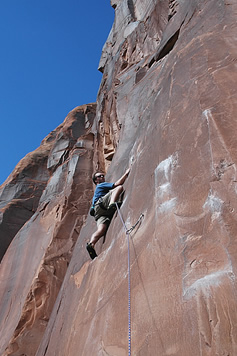Solving "Impossible" Crux Sequences
 When working on a route near your limit--often called projecting--you will sometimes hit a crux sequence that seems beyond your ability. Suppose there's a blatant lack of good holds, the sequence is uncertain, and that voice inside yourself is screaming to "back off!" What will you do in this frustrating situation? Fish or cut bait-or, in a climbers' lingo, climb on or take dirt?
When working on a route near your limit--often called projecting--you will sometimes hit a crux sequence that seems beyond your ability. Suppose there's a blatant lack of good holds, the sequence is uncertain, and that voice inside yourself is screaming to "back off!" What will you do in this frustrating situation? Fish or cut bait-or, in a climbers' lingo, climb on or take dirt? Hopefully you'll decide to give it a proud effort, realizing that even if you don't succeed in winning you will still succeed in learning. Climbing is a never-ending cycle of success and failure, and the down phase of the cycle is as important as the up phase for self-development and absolute improvement. Following are three valuable problem-solving techniques for use on projects that are resisting your best efforts.
[Climbing at Wall Street, near Moab, Utah. Horst photo.]
Embrace the Route's Feedback
Many climbers fail on routes they are physically capable of doing because they ignore the feedback the route is providing. Avoid this mind-set by embracing the feedback of failed attempts as clues toward your inevitable success. For instance, if you are tending to barndoor off the crux move, recognize that a flagging leg will increase stability. Or if you can't reach the next critical hold, look for an undercling and hip turn to extend your reach. If you still can't solve the move, the route may be hinting that there is a hidden hold or specific body position that you have yet to discover.
No matter what, believe that the route wants you to succeed regardless of your current struggles or the apparent impossible feel of the climb. In this way, view each failed attempt as a signpost directing you toward a better course of action instead of becoming obsessed with a single way the route must be done. A creative, thinking-out-of-the-box approach is most valuable.
Think Out of the Box
To break through a sticking point on a climb, you must get outside your current mind-set. The first key strategy is to exercise a flexibility of perspective. For a moment, detach yourself from the situation and visualize the problem spot from a perspective outside yourself. View yourself attempting the crux from a disassociated, on-TV perspective. See yourself trying a wide range of possible solutions, and in particular sequences that you have yet to test out in reality. It can also help to visualize how some great climber you know would attack the route-what tricks and tactics do you see him employing? Maybe a dyno past a long reach, a sequence of small foothold upgrades, or possibly a clever rest position that would provide a more rested attempt on the crux?
Another good strategy is to try a series of ridiculous, improbable moves. For example, try doing a heel hook, a twist lock, a deadpoint, a mantle, and any other move you can think of. Disregard the fact that a given move doesn't seem to be the solution--give it a try without prejudice. In attempting a variety of different techniques, you may very well stumble onto a workable sequence that you would have never surmised while climbing with the blinders on. Be creative and have fun, and above all maintain a belief that the route is possible. You might not send the climb that day, but you will make an important stride toward future success.
Focus on the Feet
When struggling on difficult move, it's a natural tendency to obsess on finding the next good handhold that will enable you to pull through. Ironically, the solution is usually a matter of better footwork and body position. Thus it's vital that you assume an intense foot-focus and resist the temptation to search for a handhold solution to your difficulties.
Stellar footwork and never-ending foot focus are hallmarks of all top climbers. This is one area where you can, and should, model the actions of these elites. Observe how the best climbers in the gym use their feet in prevailing through heinous cruxes, and then strive to let your feet similarly run the show. You will also benefit by reviewing the fundamentals of effective technique (see ongoing series of articles on technique training). Condition yourself to look down and think feet every time you begin to strain or tremble on a route. Make "focus on the feet" your climbing mantra and you will be surprised by ease at which you surmount those so-called "stopper" cruxes!



 Subscribe to Eric's RSS Feed
Subscribe to Eric's RSS Feed

<< Home